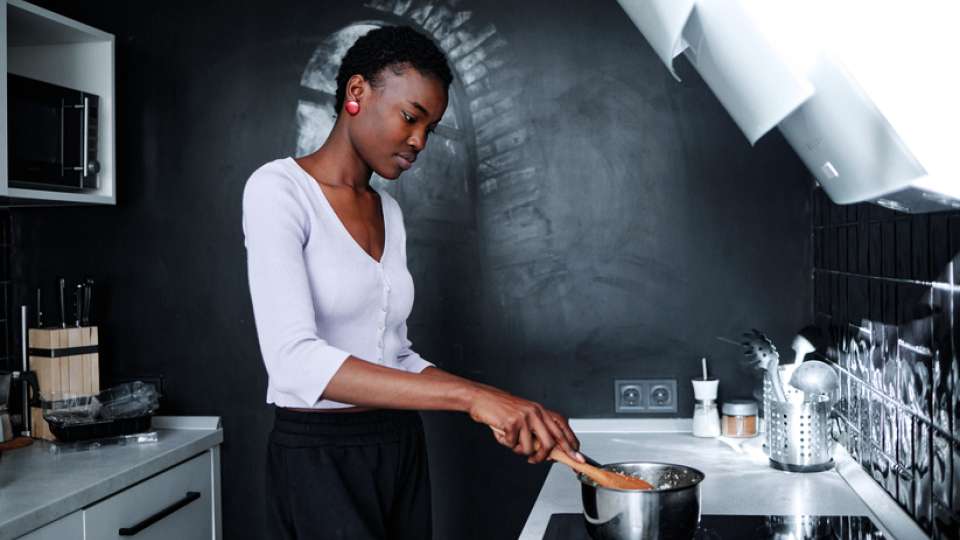
As if we don’t have enough to worry about, now TikTok is telling us we can’t eat leftover rice. Warnings about getting food poisoning from rice — or "reheated rice syndrome,” as it's been dubbed — might seem counterintuitive: Isn’t the starch one of the more benign foods in your kitchen? Do I really need to be worried about that day-old teriyaki takeout?
While you don’t necessarily need to run to your fridge to throw away your leftover rice, it is true that rice and other starches can make you sick if not properly stored. Feeling queasy? Here’s what you need to know.
How can rice make you so sick?
The culprit behind reheated rice syndrome is a spore-forming bacteria called Bacillus cereus. Unlike common foodborne bacteria like Salmonella and E. coli, cooking or reheating your food won't protect you from a Bacillus cereus infection because the toxins are heat-resistant and the spores can also survive cooking or digestion and can afterward begin growing on food or in your intestines.
“It survives the initial cooking process as a spore and if it's left out a room temperature, it'll produce toxins,” says Emily Hovis, an assistant teaching professor at the University of Washington School of Public Health, as well as a former food safety specialist for the Washington State Department of Health. “So even when you reheat it, you're killing the vegetative cells, you're not destroying the toxins.”
Most people can handle a small amount of these toxins, but if Bacillus cereus multiplies enough in the “danger zone” of between 40°F and 140°F, it can make you sick.
“People will get a really terrible vomiting illness because of this bacterial toxin that's in their food,” says Hovis. It can also cause cramps and diarrhea.
Are spore-forming bacteria found in other foods?
People often call this fried rice syndrome, sometimes making problematic (and inaccurate) stereotypes about the quality or safety of certain cultures’ cuisines. While cooked rice is a good home for Bacillus cereus — especially when left out to be refried in another dish — the spore-forming bacteria can grow on many kinds of foods.
Bacillus cereus is also found on other starches like pasta and potatoes. Another spore-forming bacteria called Clostridium perfringens grows on gravy and meats and also produces toxins resistant to cooking and reheating. It’s responsible for about 15 times the number of foodborne illnesses as Bacillus cereus and is especially prevalent around the holidays.
Staphylococcus aureus can survive in salty foods like ham and cheese and produces similar heat-resistant toxins that can sicken people after eating, say, a sandwich or charcuterie board that’s been left out too long.
What are the symptoms of reheated rice sickness?
Symptoms from Bacillus cereus form within 6 to 12 hours, which is faster than most foodborne illnesses. You can expect nausea, cramps and lots of barf. The bacteria can also cause severe diarrhea if it multiplies in your intestine and produces toxin. Either way, you’ll be spending a lot of time in the bathroom.
As awful as that sounds, you should get over it on your own within 24 hours. Stay hydrated, and if you have a fever or you’re not feeling better after a couple of days, it’s time to go to urgent care.
Am I going to die if I get sick from reheated rice?
The short answer is almost certainly not. While there have been cases of Bacillus cereus causing severe infections that lead to organ failure and even death, they have been exceedingly rare.
In fact, getting sick at all from Bacillus cereus is not super likely, compared to other sources of food poisoning. The Centers for Disease Control and Prevention estimates Bacillus cereus causes 63,000 annual cases of foodborne illness in the United States and only 20 hospitalizations. Though many cases go unreported, that’s still a tiny fraction of the 48 million total cases of foodborne illnesses in the U.S. each year.
What can I do to prevent food poisoning from rice?
Rice is often a culprit because it’s so common for people to keep it in a rice cooker, either to eat later or use in another dish.
“People either leave rice out on the counter for too long, or they don't break it into smaller pieces to cool it down quickly in the refrigerator,” says Hovis.
Some tips to avoid a Bacillus cereus infection:
- Get a good rice cooker and cook smaller portions of rice instead of big batches.
- Don’t leave rice out for more than an hour or two (the “two hour rule” applies to all cooked foods).
- If you leave it in a rice cooker on the “Keep Warm” setting, measure it with a thermometer to make sure it’s at least 150 degrees and out of the danger zone.
- If you do make a big portion, break it up into smaller storage containers before refrigerating. Don’t put a hot, covered pot of rice in the fridge that will trap heat and take a long time to cool.
- After storing rice in smaller containers, put it right in the fridge; you don’t need to wait for it to cool down first.
- Eat leftover rice within a few days, or even before that depending on your personal risk tolerance.
- When in doubt, throw it out.

 Healthy ideas for your inbox
Healthy ideas for your inbox





